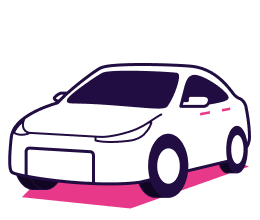How To Get a Driver's License
 Editorial Standards
Editorial Standards SmartFinancial Offers Unbiased, Fact-based Information. Our fact-checked articles are intended to educate insurance shoppers so they can make the right buying decisions. Learn More
If you're ready to get your driver's license, there are a few basic things you need to take care of first. Not only will you have to pay the applicable fees and pass certain tests, but you'll likely need to start with a driving permit before graduating to a full license.
This guide provides an overview of everything you'll need to do to get behind the wheel, including how old you need to be, what documentation is required, and what the age restrictions are for licensing. If you're just getting started on your driving journey, or if you have a child that's gearing up for the road, keep reading and see what you need to do.
How Old Do You Have to Be To Get a Driver's License?
The age requirement to get a driver's license varies across all 50 states. For example, in New Jersey and Minnesota, you must be 18 years old to get an unrestricted license, while in South Dakota and Texas you can apply for a license at 16 years old. On the low end, states like Idaho and Ohio allow teenagers to get an unrestricted license at 15 years old.
Note: There is no maximum age limit for getting a driver's license in the US, as long as you can pass the required tests. This includes a vision test, a written exam, and a skills test where you must demonstrate your ability to safely operate a vehicle. If you have any questions about the requirements in your state, be sure to contact your local DMV office.
What Documents Do You Need To Get a Driver's License?
To get a driver's license, you will need to provide some documents to prove your identity and residency. The specific documents required can vary from state to state, but they typically include a birth certificate or passport, as well as proof of your social security number and current address.
Some states may also require you to provide a copy of your high school diploma or GED. If you have recently moved to a new state, you will also need to provide proof of your previous driver's license.
Do You Have To Take a Driver's Test for a License?
Many states require drivers to take a driving test to get a license. However, there are exceptions to this. COVID-19 has caused some states to drop the skills test requirement assuming the learner has had a permit with a certain number of drive-time hours logged with another licensed individual. If you do have to take the test and don't pass, you'll need to retake it at a later date. Remember, you'll need to find the right Department of Motor Vehicles (DMV) location for your area.
How To Get a Driver's License
The requirements for getting a driver's license vary by state, but in general, you'll need to:
-
Usually, be between 16 and 18 years old (unless in Idaho or Ohio)
-
Take a behind the wheel course
-
Have a learner's permit
-
Log a certain number of hours of behind-the-wheel practice
-
Pass a written test
-
Pass a driving test
-
Pay the fee
Note: Fees vary from state to state. They can be as low as $12.50 and as high as $89.
Keep in mind that some states have a tier system beginning with a learner's permit, moving to an intermediate license, and finally to a driver's license. Once you've completed all of these steps, you'll be ready to drive. Note that some states allow you to bypass the permit stage once you've reached 18. You will, however, still need to test.
While the process may seem tedious, it is nevertheless necessary for obtaining a driver's license. Do not under any circumstances skip this process and drive without a license. It can lead to severe penalties, such as hefty fines and even jail time.
Are There Driver's License Age Restrictions?
In the United States, there are no federal laws governing the minimum age for driving a car. However, each state has different laws, and these can vary considerably. Below you will find the minimum age requirements for unrestricted driving in every state including the District of Columbia.
|
State |
Age |
State |
Age |
|
|---|---|---|---|---|
|
Alabama |
16 |
Missouri |
17 |
|
|
Alaska |
18 |
Montana |
18 |
|
|
Arizona |
18 |
Nebraska |
17 |
|
|
Arkansas |
18 |
New Hampshire |
16 |
|
|
California |
17 |
New Jersey |
18 |
|
|
Colorado |
16 |
New Mexico |
16 |
|
|
Connecticut |
16 |
New York |
16 |
|
|
Delaware |
17 |
North Carolina |
18 |
|
|
District of Columbia |
18 |
North Dakota |
16 |
|
|
Florida |
16 |
Ohio |
15 |
|
|
Georgia |
18 |
Oklahoma |
18 |
|
|
Hawaii |
17 |
Oregon |
18 |
|
|
Idaho |
15 |
Pennsylvania |
16 |
|
|
Illinois |
16 |
Rhode Island |
18 |
|
|
Indiana |
16 |
South Carolina |
18 |
|
|
Iowa |
17 |
South Dakota |
16 |
|
|
Kansas |
16 |
Tennessee |
17 |
|
|
Kentucky |
17 |
Texas |
16 |
|
|
Louisiana |
17 |
Utah |
18 |
|
|
Maine |
16 |
Vermont |
18 |
|
|
Maryland |
18 |
Virginia |
16 |
|
|
Massachusetts |
16 |
Washington |
17 |
|
|
Michigan |
17 |
West Virginia |
17 |
|
|
Minnesota |
18 |
Wisconsin |
18 |
|
|
Mississippi |
17 |
Wyoming |
16 |
Is a Permit the Same as a Driver's License?
A learner's permit and a driver's license are two different documents. A learner's permit will be issued to you when you are learning to drive. It allows you to practice driving under supervision and certain restrictions. This usually includes teens driving with their parents or a trusted and licensed supervisor typically over the age of 21.
Permit drivers also have restrictions as to when they can drive. The basic rule of thumb is you cannot drive outside of daylight hours. Also, some states will not allow permitted drivers to use hands-free electronics. Your focus needs to be on the road. There are even restrictions as to where you can drive, depending on where you live. New York, for example, does not allow drivers with a learner's permit tto operate vehicles inside certain parks, bridges associated with the Tri-borough and Tunnel Authority, or numerous parkways such as Hutchinson River or the Saw Mill River.
Once you've gone through the probationary period, you can move on to getting your license. A license, unlike a permit, allows you to drive without any restrictions as long as you're following the rules of the road. Keep in mind that each state has age limitations surrounding permits and licenses.
Get Licensed, Get Covered
Driver's licenses can usually be obtained by anyone who is between 16 and 18 years old in most states and as young as 15 in Ohio. You will need to provide various documents including your proof of identity, social security number, and residency to get your license. You will also be required to take a few tests. Remember, a permit is not the same as a driver's license; a permit allows you to drive under specific conditions while accompanied by a licensed adult driver. If you've managed to successfully get your license and need help finding the right car insurance, enter your zip code below and fill out a quick questionnaire. SmartFinancial will send you free quotes for the lowest rates in your area based on your answers.
- Insurance quotes /
- Auto /
- How To Get A Drivers License






